Analysis of Spatial—Temporal Variation in Ecosystem Service Value in Shandong Province over the Last Two Decades
Abstract
1. Introduction
2. Data Sources and Research Methodology
2.1. Overview of the Study Area
2.2. Data Sources
2.3. Research Methodology
2.3.1. Attitudinal Modeling of Land Use Change Dynamics
2.3.2. Land Use Transfer Matrix
2.3.3. Methodologies for Valuing Ecosystem Services
2.3.4. Hot Spot Analysis
2.3.5. Contribution of Ecosystem Service Value
3. Analysis of Results
3.1. Land Use Structure Change
3.1.1. Changes in Land Use Structure over Time
3.1.2. Analysis of Land Use Change Dynamics and Diversity Indices
3.1.3. Analysis of the Dynamic Land Use Transfer Matrix
3.2. Characterization of Temporal Changes in ESV
3.3. Patterns of Spatial Distribution of ESV and Characteristics of Change
3.4. Contribution of Ecosystem Service Value
4. Discussion
4.1. Discussion
4.2. ESV Estimates and Spatial and Temporal Distribution Patterns
5. Conclusions
Author Contributions
Funding
Institutional Review Board Statement
Informed Consent Statement
Data Availability Statement
Conflicts of Interest
References
- Costanza, R.; de Groot, R.; Farber, S.; Grasso, M.; Hannon, B.; Limburg, K.; Naeem, S.; Paruelo, J.; Raskin, R.G.; Sutton, P.; et al. The value of the world’s ecosystem services and natural capital. Nature 1997, 387, 253–260. [Google Scholar] [CrossRef]
- Daily, C. Nature’s Services: Societal Dependence on Natural Ecosystems; Island Press: Washington, DC, USA, 1997. [Google Scholar]
- Fu, B.; Zhang, L. Land-use change and ecosystem services: Concepts, methods and progress. Prog. Geogr. 2014, 33, 441–446. [Google Scholar]
- Yu, X.; Yang, G. The Advances and Problems of Land Use and Land Cover Change Research in China. Prog. Geogr. 2002, 21, 51–57. [Google Scholar]
- Yang, G.; Lyu, K.; Li, F. Spatial and Temporal Correlation Analysis of Land Use Change and Ecosystem Service Value in Nanchang City Based on Grid Scale. China Land Sci. 2022, 36, 122–130. [Google Scholar]
- Fu, B.; Lyu, Y.; Gao, G. Major Research Progresses on the Ecosystem Service and Ecological Safety of Main Terrestrial Eco systems in China. Chin. J. Nat. 2012, 34, 261–272. [Google Scholar]
- Li, S.; Liu, J.; Zhang, C.; Zhao, Z. The Research Trends of Ecosystem Services and the Paradigm in Geography. Acta Geogr. Sin. 2011, 66, 1618–1630. [Google Scholar]
- Liu, W.; Zhang, F.; Wei, Y.; Zhao, F. The balance between ecosystem services supply and demand in the Pearl River Delta Urban Agglomerations area. Acta Ecol. Sin. 2023, 43, 4461–4472. [Google Scholar]
- Guan, Q.; Hao, J.; Xu, Y.; Ren, G.; Kang, L. Zoning of agroecological management based on the relationship between supply and demand of ecosystem services. Resour. Sci. 2019, 41, 1359–1373. [Google Scholar]
- Liu, L.; Liu, C.; Wang, C.; Li, P. Supply and demand matching of ecosystem services in loess hilly region: A case study of Lanzhou. Acta Geogr. Sin. 2019, 74, 1921–1937. [Google Scholar]
- Chen, L.; Gong, J.; Wang, X.; Zheng, X. Spatial relationship between ecosystem services balance and urbanization in the middle reaches of the Yangtze River. Acta Ecol. Sin. 2021, 41, 5546–5556. [Google Scholar]
- Wang, S.; Zhang, Q.; Wang, Z.; Yu, L.; Xiang, S.; Gao, M. GIS-based ecological risk assessment and ecological zoning in the Three Gorges Reservoir area. Acta Ecol. Sin. 2022, 42, 4654–4664. [Google Scholar]
- Qiu, J.; Liu, Y.; Chen, C.; Huang, Q. Spatial structure and driving pathways of the coupling between ecosystem services and human well-beings: A case study of Guangzhou. J. Nat. Resour. 2023, 38, 760–778. [Google Scholar]
- Wei, H.; Zhao, W.; Zhang, X.; Wang, X. Regional ecosystem service value evaluation based on land use changes: A case study in Dezhou, Shandong Provience, China. Acta Ecol. Sin. 2017, 37, 3830–3839. [Google Scholar]
- Blumstein, M.; Thompson, J.R. Land-use impacts on the quantity and configuration of ecosystem service provisioning in Massachusetts, USA. J. Appl. Ecol. 2015, 52, 1009–1019. [Google Scholar] [CrossRef]
- Zhang, Y.; Zhao, L.; Liu, J.; Liu, Y.; Li, C. The Impact of Land Cover Change on Ecosystem Service Values in Urban Agglomerations along the Coast of the Bohai Rim, China. Sustainability 2015, 7, 10365–10387. [Google Scholar] [CrossRef]
- Guo, C.; Gao, S.; Zhou, B.; Gao, J. Effects of land use change on ecosystem service value in Funiu Mountain based upon a grid square. Acta Ecol. Sin. 2019, 39, 3482–3493. [Google Scholar]
- Shu, B.; Li, Y.; Wang, L.; He, Z.; Wang, M. Spatial and temporal dynamic changes of land use and ecosystem service value in Leshan City. Ecol. Sci. 2022, 41, 159–168. [Google Scholar]
- Guan, Q.; Hao, J.; Shi, X.; Gao, Y.; Wang, H.; Li, M. Study on the Changes of Ecological Land and Ecosystem Service Value in China. J. Nat. Resour. 2018, 33, 195–207. [Google Scholar]
- Yin, D.; Zhang, Q.; Zhai, T. Land use change and its impact on ecosystem service value in Shandong Province. Bull. Soil Water Conserv. 2018, 38, 134–143. [Google Scholar]
- An, G.; Han, Y.; Gao, N.; Ji, L.; Gao, H.; Tan, X.; Xu, Y. Ouantity and equilibrium of ecosystem service value and their spatial distribution patterns in Shandong Province. China Popul. Resour. Environ. 2021, 31, 9–18. [Google Scholar]
- Zhao, H.; Mo, H. Spatial-temporal change of ecosystem service value in Changsha-Zhuzhou-Xiangtan urban agglomeration. Sci. Surv. Mapp. 2022, 47, 206–215. [Google Scholar]
- Chen, W.; Li, J.; Zhu, L. Spatial heterogeneity and sensitivity analysis of ecosystem services value in the Middle Yangtze River region. J. Nat. Resour. 2019, 34, 325–337. [Google Scholar] [CrossRef]
- Gao, X.; Yang, L.; Li, C.; Song, Z.; Wang, J. Land use change and ecosystem service value measurement in Baiyangdian Basin under the simulated multiple scenarios. Acta Ecol. Sin. 2021, 41, 7974–7988. [Google Scholar]
- Liu, H.; Shu, C.; Zhou, T.; Liu, P. Trade-off and Synergy Relationships of Ecosystem Services and Driving Force Analysis based on Land Cover Change in Altay Prefecture. Resour. Ecol. 2021, 12, 777–790. [Google Scholar]
- Wang, Y.; Zhang, X.; Peng, P. Spatio-Temporal Changes of Land-Use/Land Cover Change and the Effects on Ecosystem Service Values in Derong County, China, from 1992–2018. Sustainability 2021, 13, 827. [Google Scholar] [CrossRef]
- Egarter, V.L.; Tasser, E.; Schirpke, U.; Tappeiner, U. Using land use/land cover trajectories to uncover ecosystem service patterns across the Alps. Reg. Environ. Chang. 2017, 17, 2237–2250. [Google Scholar] [CrossRef]
- Wang, Y.; Ding, J.; Li, X.; Zhang, J.; Ma, G. Impact of LUCC on ecosystem services values in the Yili River Basin based on an intensity analysis model. Acta Ecol. Sin. 2022, 42, 3106–3118. [Google Scholar]
- Xie, G.; Zhang, C.; Zhang, C.; Xiao, Y.; Lu, C. The value of ecosystem services in China. Resour. Sci. 2015, 37, 1740–1746. [Google Scholar]
- Han, H.; Yang, C.; Song, J. The Spatial-Temporal Characteristic of Land Use Change in Beijing and Its Driving Mechanism. Econ. Geogr. 2015, 35, 148–154, 197. [Google Scholar]
- Zhu, H.; Li, X. Discussion on the Index Method of Regional Land Use Change. Acta Geogr. Sin. 2003, 58, 643–650. [Google Scholar]
- Xie, G.; Lu, C.; Leng, Y.; Zheng, D.; Li, S. Ecological assets valuation of the Tibetan Plateau. J. Nat. Resour. 2003, 18, 189–196. [Google Scholar]
- Zhang, F.; Yusufujiang, R.; Aierken, T. Spatio-temporal change of ecosystem service value in Bosten Lake Watershed based on land use. Acta Ecol. Sin. 2021, 41, 5254–5265. [Google Scholar]
- Feng, J.; Guo, L.; Li, X. Temporal and Spatial Variations of Land Uses and Their Influences on Ecosystem Service Function Values in Hanzhong City. Res. Soil Water Conserv. 2020, 27, 275–282. [Google Scholar]
- Zhou, Y.; Li, X.; Liu, Y. Land use change and driving factors in rural China during the period 1995–2015. Land Use Policy 2020, 99, 105048. [Google Scholar] [CrossRef]
- Zhang, X.; Ren, W.; Peng, H. Urban land use change simulation and spatial responses of ecosystem service value under multiple scenarios: A case study of Wuhan, China. Ecol. Indic. 2022, 144, 109526. [Google Scholar] [CrossRef]
- Fang, Z.; Ding, T.; Chen, J.; Xue, S.; Zhou, Q.; Wang, Y.; Wang, Y.; Huang, Z.; Yang, S. Impacts of land use/land cover changes on ecosystem services in ecologically fragile regions. Sci. Total Environ. 2022, 831, 154967. [Google Scholar] [CrossRef]
- Shi, Y.; Shi, D. Study on the balance of ecological service supply and demand in Dongting Lake ecological economic zone. Geogr. Res. 2018, 37, 1714–1723. [Google Scholar]
- Tolessa, T.; Senbeta, F.; Kidane, M. The impact of land use land cover change on ecosystem services in the central highlands of Ethiopia. Ecosyst. Serv. 2017, 23, 47–54. [Google Scholar] [CrossRef]
- Wang, D.; Jing, Y.; Han, S. Research on the spatial coupling relationship between land-use patternand ecosystem services valuein Nansi Lake basin based upon a grid square. J. Qufu Norm. Univ. 2023, 49, 96–105. [Google Scholar]
- Guan, M.; Zhang, W.; Jiang, H.; Lu, C.; Ge, Y.; Dong, G. Cross-sensitivity evaluation of ecosystem services based onland use changes in Shandong Province. J. China Agric. Univ. 2022, 27, 192–203. [Google Scholar]
- Liu, X.; Zhai, X.; Saishal; Liu, Y.; Sun, H. The Research on the Evaluation Method and Balance Sheet Establishing of Grassland Natural Resources Assets. Ecol. Econ. 2016, 32, 28–36. [Google Scholar]
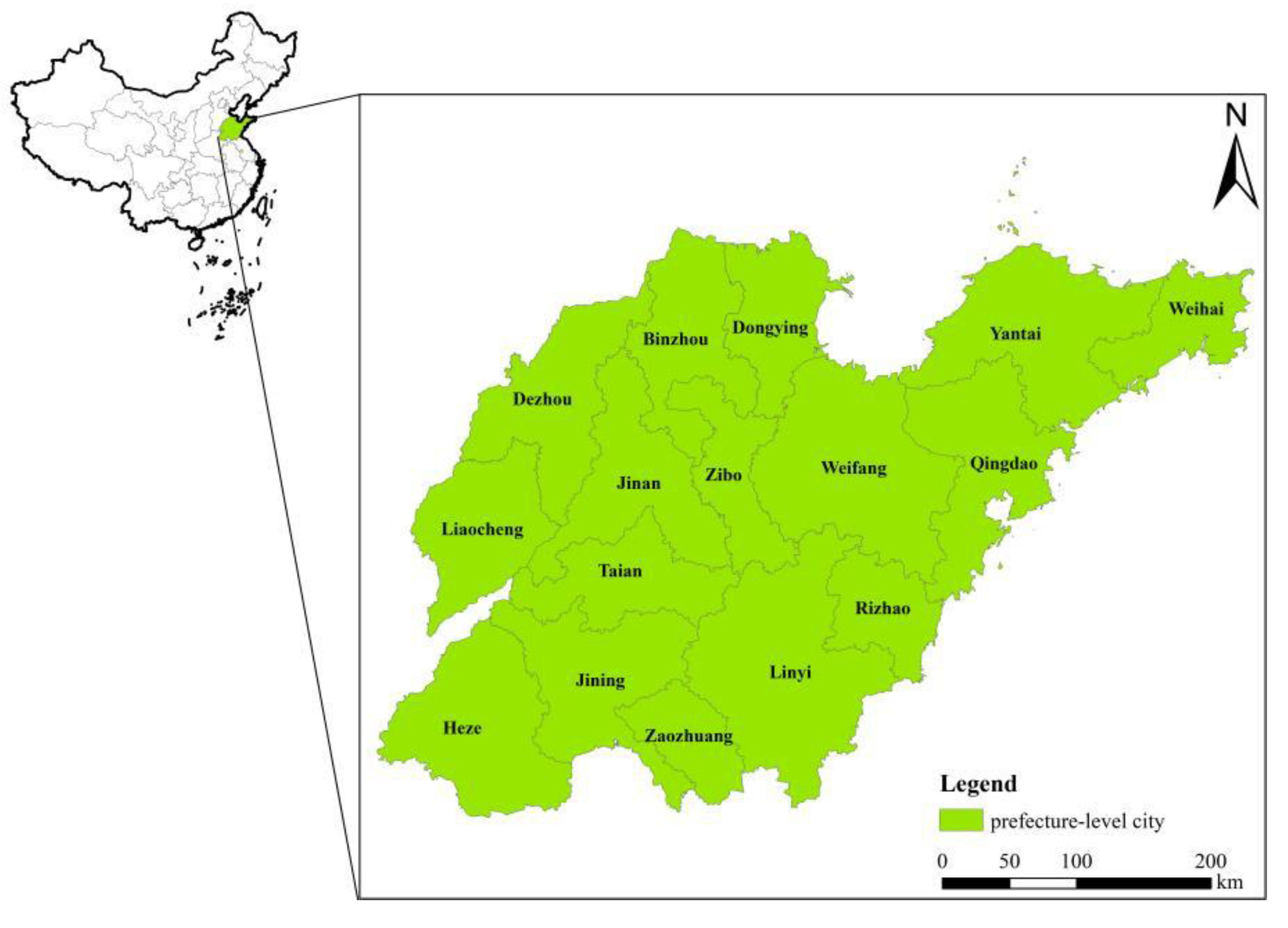

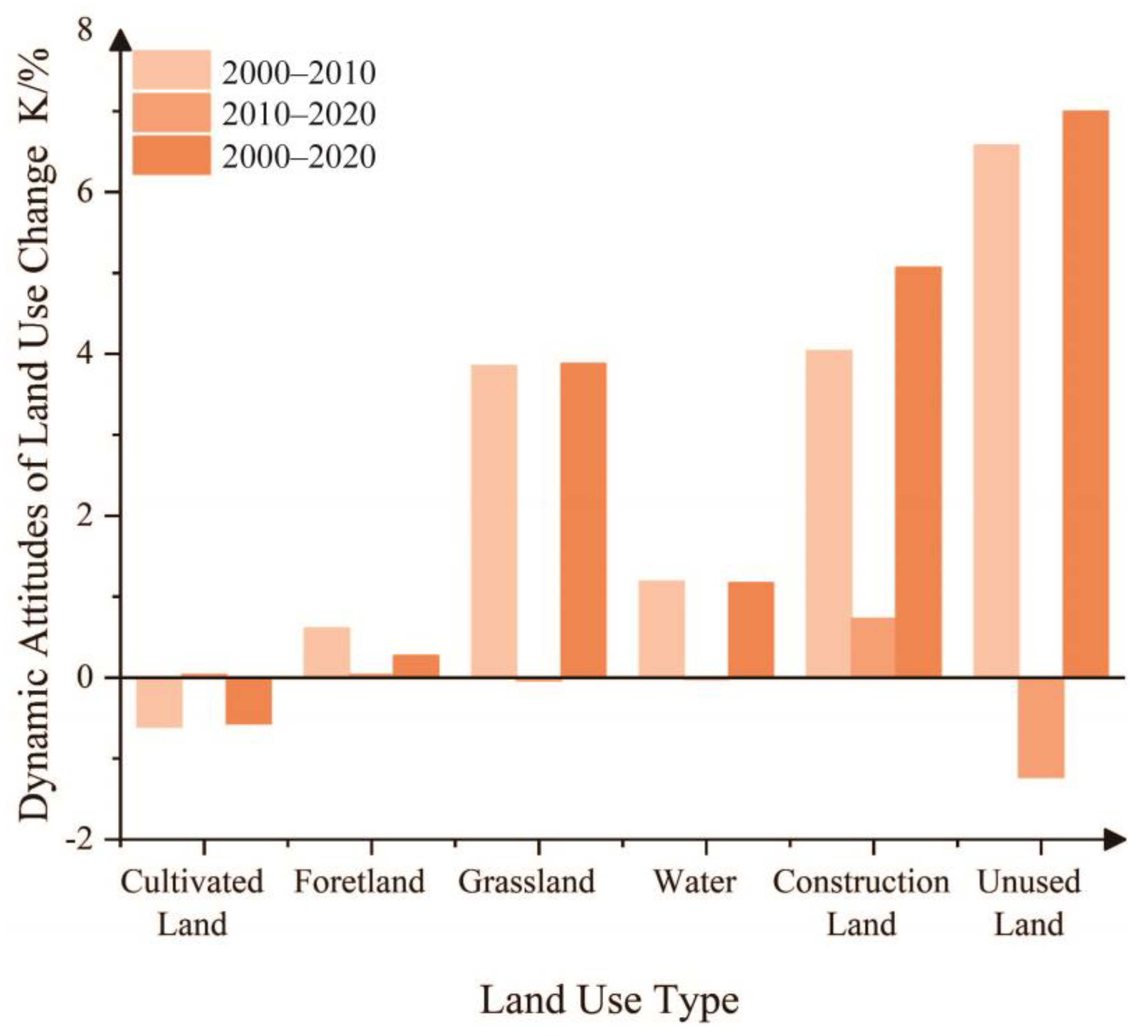
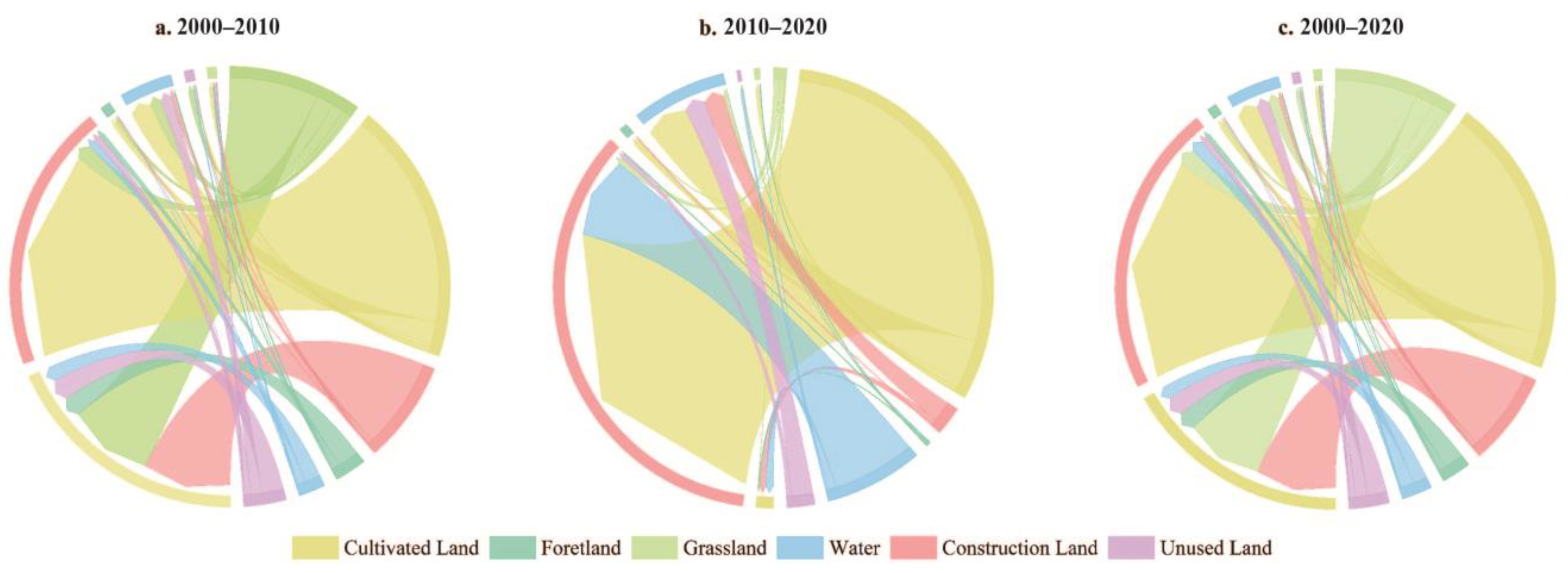
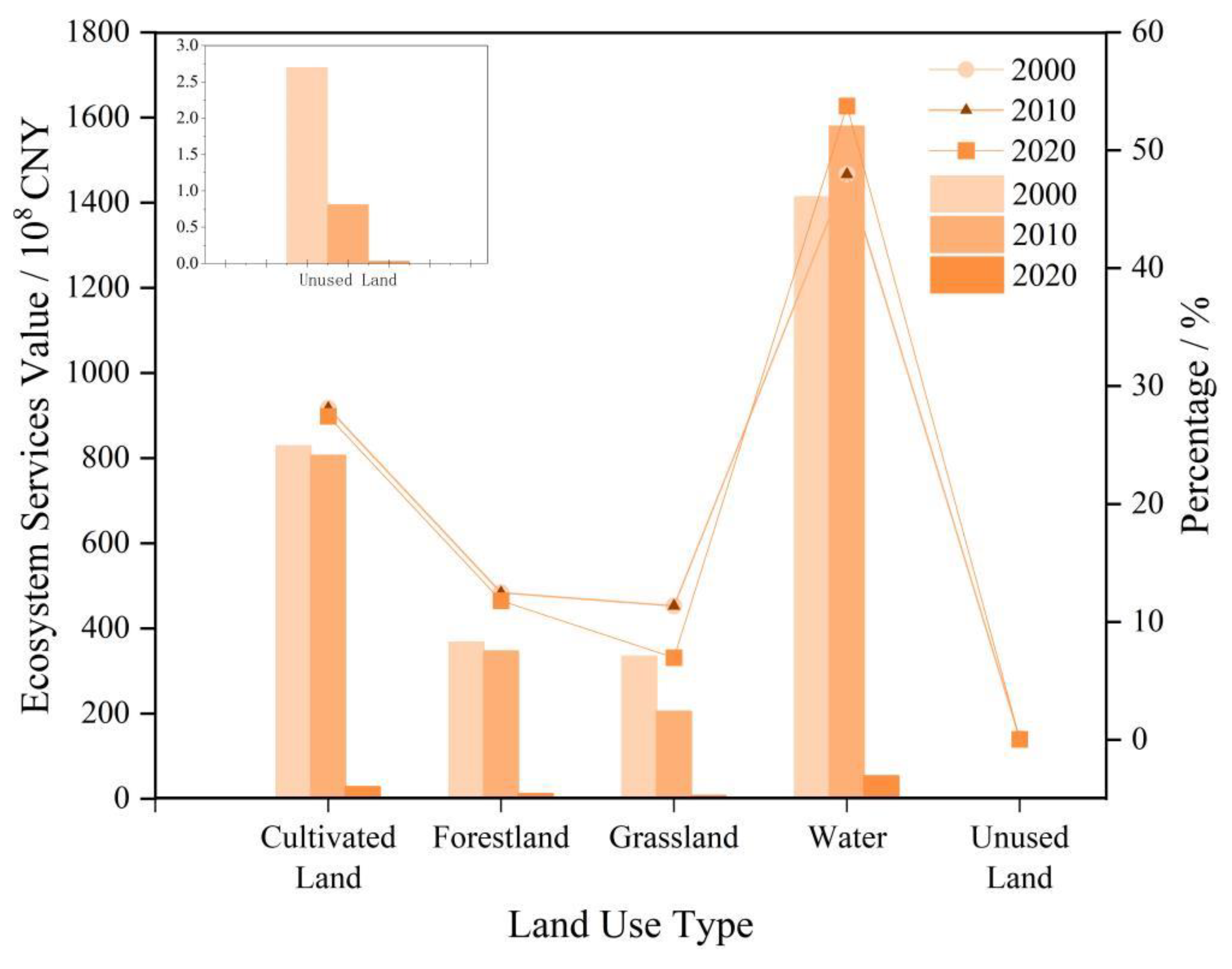



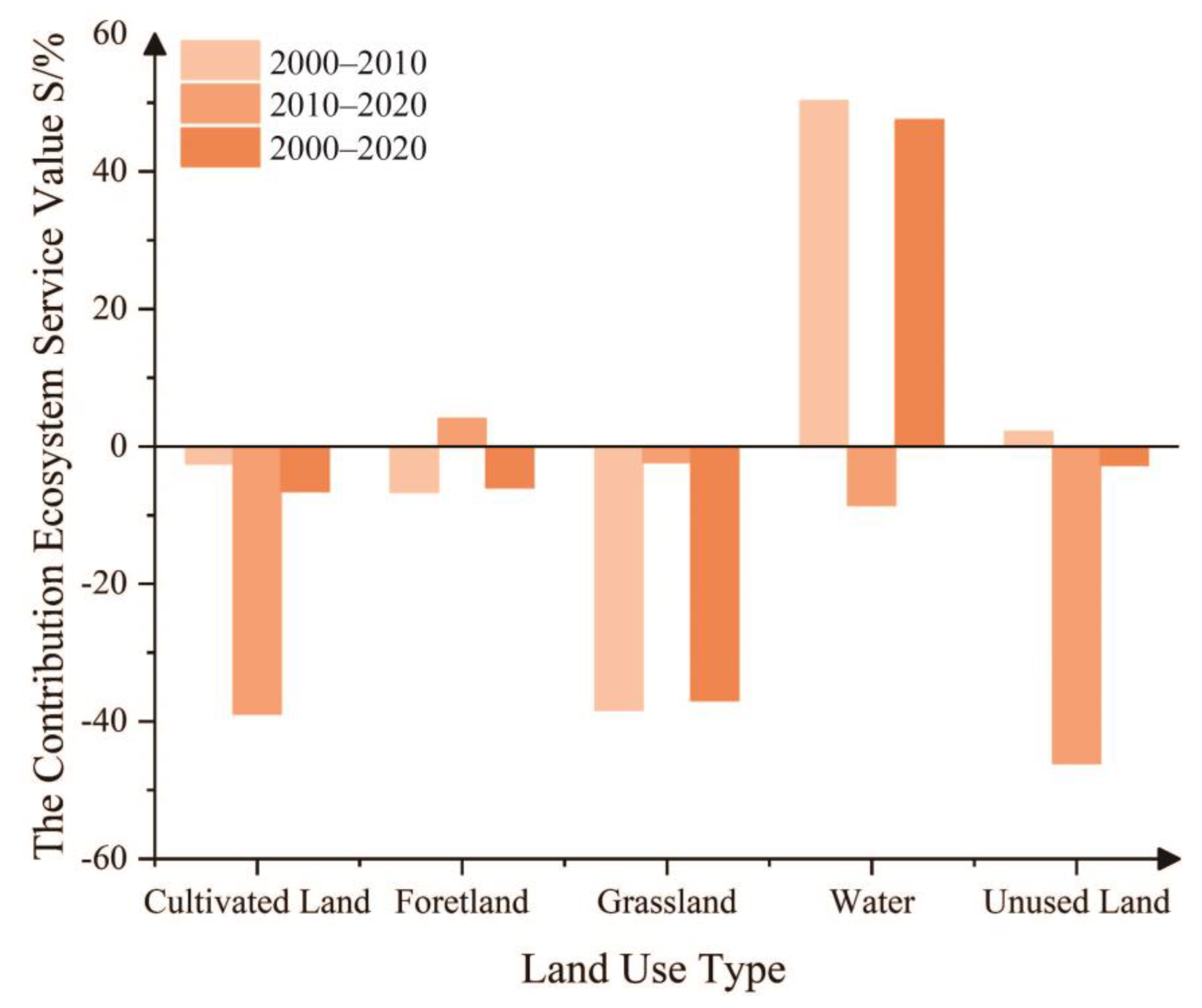
| Primary Ecosystem Services | Secondary Ecosystem Services | Cultivated Land | Forestland | Grassland | Water | Unused Land |
|---|---|---|---|---|---|---|
| Provisioning services | Food supply | 1701.03 | 480.29 | 466.95 | 1310.79 | 10.01 |
| Raw material supply | 800.49 | 1090.66 | 687.08 | 730.44 | 30.02 | |
| Water supply | 40.02 | 560.34 | 380.23 | 10,886.60 | 20.01 | |
| Regulating services | Gas regulation | 1340.81 | 3582.17 | 2414.80 | 2671.62 | 130.08 |
| Climate regulation | 720.44 | 10,736.51 | 6383.87 | 5893.57 | 100.06 | |
| Environment purification | 200.12 | 3211.95 | 2107.94 | 9155.55 | 410.25 | |
| Hydrological regulation | 540.33 | 8094.91 | 4676.17 | 126,546.74 | 240.15 | |
| Supporting services | Soil conservation | 2061.25 | 4372.65 | 2941.78 | 3241.97 | 150.09 |
| Maintaining nutrient cycling | 240.15 | 330.20 | 226.80 | 250.15 | 10.01 | |
| Biodiversity | 260.16 | 3982.41 | 2674.96 | 10,426.32 | 140.08 | |
| Cultural services | Aesthetic landscape | 120.07 | 1751.06 | 1180.72 | 6624.02 | 60.04 |
| Total | 8382.26 | 8024.87 | 38,193.16 | 24,141.31 | 177,737.78 | |
| Year | Cultivated Land | Forestland | Grassland | Water | Construction Land | Unused Land | ||||||
|---|---|---|---|---|---|---|---|---|---|---|---|---|
| Area /hm2 | Proportions/% | Area /hm2 | Proportions/% | Area /hm2 | Proportions/% | Area /hm2 | Proportions/% | Area /hm2 | Proportions/% | Area /hm2 | Proportions/% | |
| 2000–2010 | −106,078 | −0.70 | −58,622 | −0.38 | −533,882 | −3.44 | 94,912 | 0.61 | 743,247 | 4.79 | −136,436 | −0.88 |
| 2010–2020 | −176,216 | −1.14 | 3838 | 0.03 | −3489 | −0.02 | −1745 | −0.02 | 188,429 | 1.21 | −8724 | −0.06 |
| 2000–2020 | −282,294 | −1.84 | −54,784 | −0.35 | −537,371 | −3.46 | 93,168 | 0.59 | 931,676 | 6.00 | −145,160 | −0.94 |
| Ecosystem Services | 2000 | 2010 | 2020 | ||||||
|---|---|---|---|---|---|---|---|---|---|
| ESV | Percentage | ESV | Percentage | Change 2000–2010 ESV | ESV | Percentage | Change 2000–2010 ESV | ||
| Provisioning services | FS | 197.17 | 6.69 | 193.82 | 6.56 | −3.35 | 190.80 | 6.50 | −3.02 |
| RMS | 108.54 | 3.68 | 10.03 | 3.52 | −4.50 | 102.63 | 3.49 | −1.41 | |
| WS | 101.41 | 3.44 | 109.32 | 3.7 | 7.90 | 109.06 | 3.71 | −0.25 | |
| Regulating services | GR | 227.90 | 7.73 | 213.84 | 7.24 | −14.06 | 211.47 | 7.20 | −2.37 |
| CR | 313.27 | 10.6 | 277.58 | 9.4 | −35.68 | 276.39 | 9.41 | −1.19 | |
| EP | 154.45 | 5.24 | 149.23 | 5.05 | −5.22 | 148.73 | 5.06 | −0.50 | |
| HR | 1205.35 | 40.9 | 1294.85 | 43.8 | 89.50 | 1291.81 | 43.98 | −3.03 | |
| Supporting services | SC | 321.77 | 10.9 | 304.19 | 10.3 | −17.58 | 300.55 | 10.23 | −3.64 |
| MN | 33.13 | 1.12 | 31.69 | 1.07 | −1.44 | 31.27 | 1.06 | −0.42 | |
| CB | 185.47 | 6.29 | 178.28 | 6.04 | −7.19 | 177.69 | 6.05 | −0.59 | |
| Cultural services | AL | 98.42 | 3.34 | 97.16 | 3.29 | −1.25 | 96.86 | 3.30 | −0.31 |
| Total | 2946.86 | 100 | 2953.99 | 100 | 14.26 | 2937.26 | 100.00 | −33.46 | |
Disclaimer/Publisher’s Note: The statements, opinions and data contained in all publications are solely those of the individual author(s) and contributor(s) and not of MDPI and/or the editor(s). MDPI and/or the editor(s) disclaim responsibility for any injury to people or property resulting from any ideas, methods, instructions or products referred to in the content. |
© 2024 by the authors. Licensee MDPI, Basel, Switzerland. This article is an open access article distributed under the terms and conditions of the Creative Commons Attribution (CC BY) license (https://creativecommons.org/licenses/by/4.0/).
Share and Cite
Li, T.; Shi, D.; Jiang, S.; Li, Y.; Yu, H. Analysis of Spatial—Temporal Variation in Ecosystem Service Value in Shandong Province over the Last Two Decades. Sustainability 2024, 16, 515. https://doi.org/10.3390/su16020515
Li T, Shi D, Jiang S, Li Y, Yu H. Analysis of Spatial—Temporal Variation in Ecosystem Service Value in Shandong Province over the Last Two Decades. Sustainability. 2024; 16(2):515. https://doi.org/10.3390/su16020515
Chicago/Turabian StyleLi, Ting, Donghui Shi, Shuguang Jiang, Yu Li, and Huilu Yu. 2024. "Analysis of Spatial—Temporal Variation in Ecosystem Service Value in Shandong Province over the Last Two Decades" Sustainability 16, no. 2: 515. https://doi.org/10.3390/su16020515
APA StyleLi, T., Shi, D., Jiang, S., Li, Y., & Yu, H. (2024). Analysis of Spatial—Temporal Variation in Ecosystem Service Value in Shandong Province over the Last Two Decades. Sustainability, 16(2), 515. https://doi.org/10.3390/su16020515







